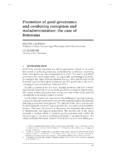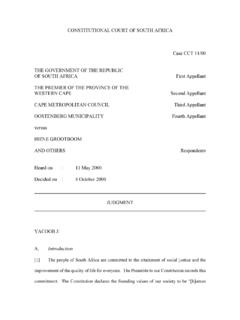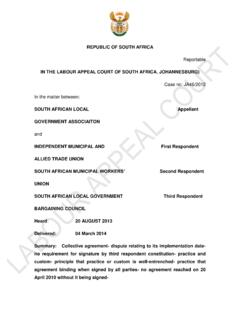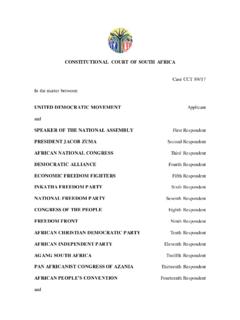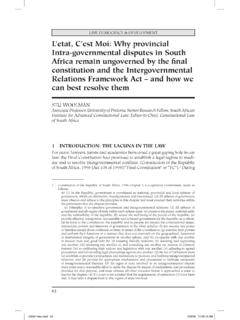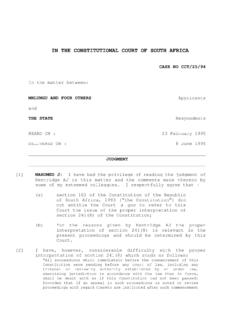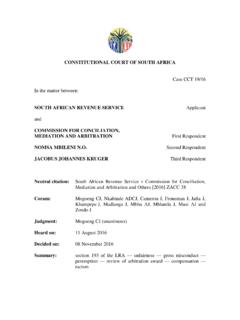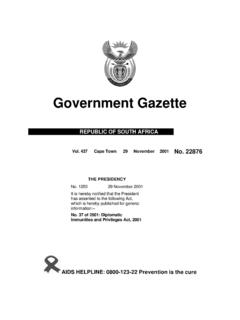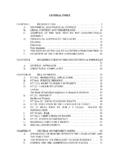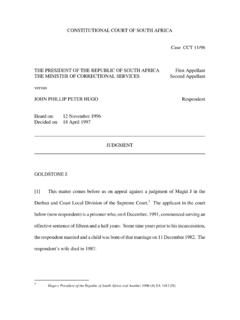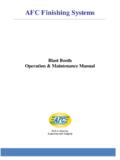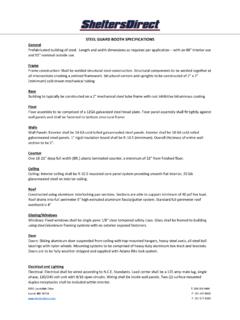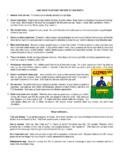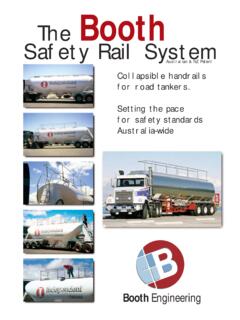Transcription of Cases No: 2046/12 & 22990/11 In the matter …
1 THE HIGH COURT OF SOUTH AFRICA (WESTERN CAPE HIGH COURT) Cases No: 2046/12 & 22990/11 In the matter between: Reportable WILLIAM BOOTH & 2 OTHERS NNO APPLICANTS And MINISTER OF LOCAL GOVERNMENT, ENVIRONMENTAL AFFAIRS & DEVELOPMENT PLANNING FIRST RESPONDENT CITY OF CAPE TOWN SECOND RESPONDENT 2 And in the matter between CITY OF CAPE TOWN APPLICANT And WILLIAM BOOTH ATTORNEYS & 5 OTHERS RESPONDENTS Coram: ROGERS J Heard: 18 FEBRUARY 2013 Delivered: 6 MARCH 2013 3 _____ JUDGMENT _____ ROGERS J: [1] The Booth Family Trust ( BFT ) is the owner of Erf 64403 situated at 29 Kenilworth Road, Cape Town ( the property ). William Booth Attorneys ( WBA ), a firm comprising two attorneys (including the eponymous Mr William Booth, a well-known criminal defence lawyer), conducts a law practice at the property.
2 [2] In terms of the applicable zoning scheme the property is zoned General Residential. This zoning does not permit the use of the property for purposes of a law practice, even though WBA has been conducting its practice there for many years. On 26 August 2008 the BFT submitted to the City of Cape Town ( the City ) an application to rezone the property as Special Business. This zoning would have permitted the conduct of a law practice. On 19 August 2009 the City s Protea Sub-Council ( the PSC ) refused the rezoning application. BFT filed an internal appeal in terms of s 62 of the Local Government: Municipal Systems Act 32 of 2000 ( the Systems Act ). On 16 July 2010 the City s Planning & General Appeals Committee ( the PGAC ) dismissed the appeal. BFT filed a further appeal to the Minister of Local Government, Environmental Affairs & Development Planning, Western Cape ( the MEC ) in terms of s 44 of the Land Use Planning Ordinance 15 of 1985 ( LUPO ).
3 On 13 October 2011 the MEC dismissed the appeal. [3] Following the MEC s dismissal of the appeal, the City on 14 November 2011 issued an application for a declaratory order that WBA s use of the property as a law practice was unlawful and for an interdict against the unlawful use. The interdict cited as respondents BFT, WBA and the two partners in WBA (Mr Booth and Mr Mia). The respondents opposed the interdict application, relying mainly on the fact 4 that BFT enjoyed (so they said) strong prospects of having the MEC s decision set aside on review. Following the furnishing of reasons by the MEC on 31 January 2012, BFT issued a review application on 6 February 2012, citing only the MEC as a respondent. Following an earlier postponement of the interdict application on 12 December 2011 to afford the City time to file replying papers in response to belated answering papers from the respondents, the interdict application was on 7 February 2012, and despite opposition from the City, postponed sine die.
4 In August 2012, by which time the City had at its own instance been joined as the second respondent in the review, orders were made by agreement for the interdict and review application to be heard together on 18 February 2013. The two applications served before me on that date. [4] I shall for convenience refer to the BFT, WBA and Mr Booth as Booth except where a distinction is necessary. [5] Mr Booth bought the property in 1994. He sold it to the BFT during 1997. The precise date on which WBA began to conduct its practice from the property is unclear. On one view it was as early as 1990/1991. It is at any rate common cause that WBA has used the property for its law practice for more than 16 years. The zoning of the property has at no time permitted such use. [6] There have been various attempts by Booth over the years, mainly unsuccessful, to regularise WBA s use of the property.
5 In 1996 he applied for a temporary departure in terms of s 15 of LUPO, which the local authority refused in 1997. In October 1997 Booth submitted a rezoning application which the local authority refused in July 1998. There was an appeal to the MEC in terms of s 44 of LUPO which the MEC rejected in September 1999. Following this rejection there were several futile and somewhat maladroit efforts by the City to pursue criminal action against Booth. [7] When the criminal proceedings appeared to the City to be going nowhere, the City decided rather to seek a civil interdict. An application was issued in December 2001. On 18 November 2002 and by agreement an order was made postponing the interdict application to 14 May 2003 to afford Booth time to submit a further 5 administrative application to regularise WBA s use of the property. This took the form of an application for a departure in terms of s 15 of LUPO, lodged in February 2003.
6 The interdict application was removed from the roll to allow the new departure application to be determined and was not thereafter revived. [8] The City refused the departure application on 30 October 2003. Booth pursued an internal appeal in terms of s 62 of the Systems Act. The appeal was refused on 6 August 2004, whereupon Booth lodged an appeal to the MEC in terms of s 44 of LUPO. On 8 December 2005 the MEC upheld the appeal and granted the temporary departure. The MEC s decision was that the temporary departure was valid for a period of two years only, during which time the premises shall be rehabilitated to make it more suitable for a private residence . The papers do not reveal precisely what Booth had in mind in seeking the temporary departure. The MEC s decision indicates that the departure was a temporary indulgence after which the premises would have to be returned to residential use - it was not a long-term solution to Booth s problems.
7 [9] On 8 December 2007 the two-year period of the departure lapsed. Nothing changed WBA continued to practise from the property. In April 2008 the City served a notice in terms of s 39(2) of LUPO requiring the BFT to cease its unlawful use of the property. This had no effect. Over the period June to November 2008 the City turned again to the criminal courts with no greater success or proficiency than before. While these steps were being pursued, Booth on 26 August 2008 filed the rezoning application which is the subject of the current proceedings. Its fate and the ensuing legal history I have summarized in paragraphs 2 and 3 above. The legislative framework [10] An application for rezoning is made in terms of ss 16 and 17 of LUPO, which form part of Chapter II. [11] Section 36 of LUPO reads thus: 6 36 Basis of refusal of applications and particulars applicable at granting thereof (1) Any application under Chapter II or III shall be refused solely on the basis of a lack of desirability of the contemplated utilisation of land concerned including the guideline proposals included in a relevant structure plan in so far as it relates to desirability, or on the basis of its effect on existing rights concerned (except any alleged right to protection against trade competition).
8 (2) Where an application under Chapter II or III is not refused by virtue of the matters referred to in subsection (1) of this section, regard shall be had, in considering relevant particulars, to only the safety and welfare of the members of the community concerned, the preservation of the natural and developed environment concerned or the effect of the application on existing rights concerned (with the exception of any alleged right to protection against trade competition). [12] Section 39(2)(a)(i) provides that no person shall contravene or fail to comply with provisions incorporated in a zoning scheme except in accordance with the intention of a plan for a building as approved and to the extent that such plan has been implemented. In terms of s 46(1)(a) a contravention is a criminal offence punishable by a fine not exceeding R10 000 or imprisonment not exceeding five years or both.
9 First ground of review [13] Despite the numerous review grounds advanced in the papers, Mr WG Burger SC, who appeared with Mr MV Combrink for Booth, focused his oral submissions on two points. He did not abandon the other grounds but made no submissions in support of them. Mr Burger, I should perhaps add, replaced Booth s former lead counsel at a relatively late stage. He was not a co-author of the heads of argument filed for Booth on 1 February 2013. [14] The first ground which Mr Burger developed was that the MEC had based his decision on the Land Use Management Policy for Kenilworth Main Road (Between 7 Claremont & Wynberg) and Kenilworth Road ( the KRP 1). Mr Burger submitted that the MEC had viewed the KRP not as a guideline but as a rule to be followed and in so doing had failed to give proper attention to Booth s appeal. [15] The City adopted the KRP on 5 June 2007.
10 In formulating the KRP the City was assisted by CN de V Africa Urban & Environmental Planners, a firm of town planners. The adoption of the KRP was preceded by a process of public participation. [16] Kenilworth Road runs at a modest incline from the east (Rosmead Avenue) to the north (Main Road). Roughly halfway up Kenilworth Road one reaches the southern suburbs railway line. The railway crossing is controlled by booms which are closed during peak hours. Kenilworth Station is immediately to the south of the booms (to the left as one travels up Kenilworth Road). Thomas Road (to the south) and Harfield Road (to the north) run parallel with, and just above (ie to the west of), the railway line. [17] The KRP, in a section on the historical background, stated that Kenilworth Road and the Kenilworth Main Road had faced development pressure for a long period.
